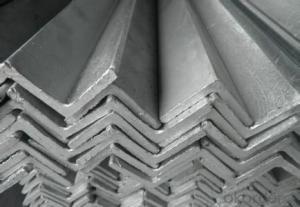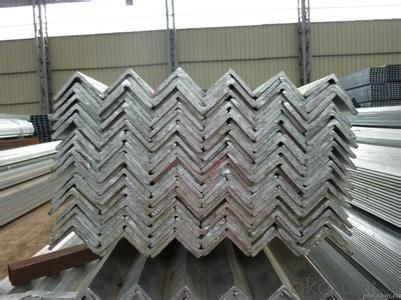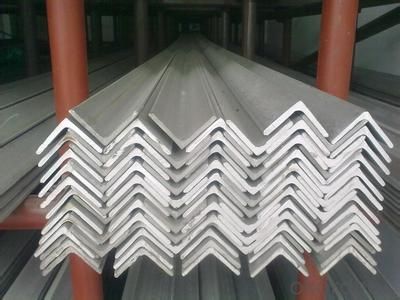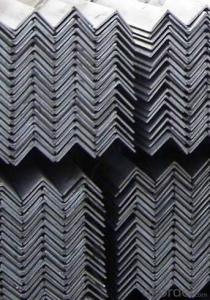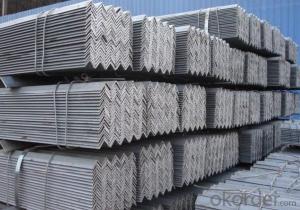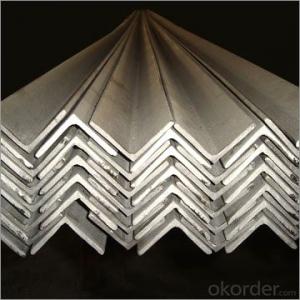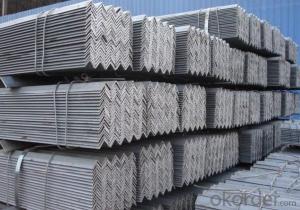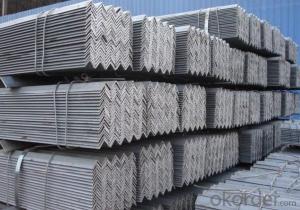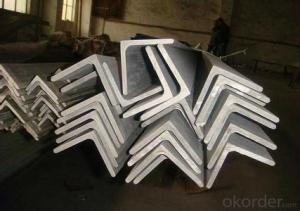GB Q235B 20-250MM equal angle steel High quality hot rolled
- Loading Port:
- Tianjin
- Payment Terms:
- TT OR LC
- Min Order Qty:
- 25 m.t.
- Supply Capability:
- 200000 m.t./month
OKorder Service Pledge
OKorder Financial Service
You Might Also Like
Angle Steel Details:
| Minimum Order Quantity: | 25mtons | Unit: | m.t. | Loading Port: | China Main Port |
| Supply Ability: | 80000-100000MTS/YEAR | Payment Terms: | TT or LC |
Product Description:
Specifications of Angle Steel
1. Invoicing on theoretical weight or actual weight as customer request
2. Length: 6m, 9m, 12m as following table
3. Sizes

Sizes: 25mm-250mm | ||
a*t | ||
25*2.5-4.0 | 70*6.0-9.0 | 130*9.0-15 |
30*2.5-6.6 | 75*6.0-9.0 | 140*10-14 |
36*3.0-5.0 | 80*5.0-10 | 150*10-20 |
38*2.3-6.0 | 90*7.0-10 | 160*10-16 |
40*3.0-5.0 | 100*6.0-12 | 175*12-15 |
45*4.0-6.0 | 110*8.0-10 | 180*12-18 |
50*4.0-6.0 | 120*6.0-15 | 200*14-25 |
60*4.0-8.0 | 125*8.0-14 | 250*25 |
5. Payment terms:
1).100% irrevocable L/C at sight.
2).30% T/T prepaid and the balance against the copy of B/L.
3).30% T/T prepaid and the balance against L/C
6.Material details:
Alloy No | Grade | Element (%) | |||||
C | Mn | S | P | Si | |||
|
|
|
|
|
|
| |
Q235 | B | 0.12—0.20 | 0.3—0.7 | ≤0.045 | ≤0.045 | ≤0.3 | |
|
|
|
|
|
|
| |
Alloy No | Grade | Yielding strength point( Mpa) | |||||
Thickness (mm) | |||||||
≤16 | >16--40 | >40--60 | >60--100 | ||||
≥ | |||||||
|
|
|
|
|
| ||
Q235 | B | 235 | 225 | 215 | 205 | ||
Alloy No | Grade | Tensile strength (Mpa) | Elongation after fracture (%) | ||||
Thickness (mm) | |||||||
| ≤16 | >16--40 | >40--60 | >60--100 | |||
≥ | |||||||
|
|
|
|
|
|
| |
Q235 | B | 375--500 | 26 | 25 | 24 | 23 | |
Usage & Applications of Angle Steel
According to the needs of different structures, Angle can compose to different force support component, and also can be the connections between components. It is widely used in various building structures and engineering structures such as roof beams, bridges, transmission towers, hoisting machinery and transport machinery, ships, industrial furnaces, reaction tower, container frame and warehouse etc.
Packaging & Delivery of Angle Steel
1. Packing: it is nude packed in bundles by steel wire rod
2. Bundle weight: not more than 3.5MT for bulk vessel; less than 3 MT for container load
3. Marks:
Color marking: There will be color marking on both end of the bundle for the cargo delivered by bulk vessel. That makes it easily to distinguish at the destination port.
Tag mark: there will be tag mark tied up on the bundles. The information usually including supplier logo and name, product name, made in China, shipping marks and other information request by the customer.
If loading by container the marking is not needed, but we will prepare it as customer request.
Production flow of Angle Steel
Material prepare (billet) —heat up—rough rolling—precision rolling—cooling—packing—storage and transportation
Angle Steel Details:
| Minimum Order Quantity: | 25mtons | Unit: | m.t. | Loading Port: | China Main Port |
| Supply Ability: | 80000-100000MTS/YEAR | Payment Terms: | TT or LC |
Product Description:
Specifications of Angle Steel
1. Invoicing on theoretical weight or actual weight as customer request
2. Length: 6m, 9m, 12m as following table
3. Sizes

Sizes: 25mm-250mm | ||
a*t | ||
25*2.5-4.0 | 70*6.0-9.0 | 130*9.0-15 |
30*2.5-6.6 | 75*6.0-9.0 | 140*10-14 |
36*3.0-5.0 | 80*5.0-10 | 150*10-20 |
38*2.3-6.0 | 90*7.0-10 | 160*10-16 |
40*3.0-5.0 | 100*6.0-12 | 175*12-15 |
45*4.0-6.0 | 110*8.0-10 | 180*12-18 |
50*4.0-6.0 | 120*6.0-15 | 200*14-25 |
60*4.0-8.0 | 125*8.0-14 | 250*25 |
5. Payment terms:
1).100% irrevocable L/C at sight.
2).30% T/T prepaid and the balance against the copy of B/L.
3).30% T/T prepaid and the balance against L/C
6.Material details:
Alloy No | Grade | Element (%) | |||||
C | Mn | S | P | Si | |||
|
|
|
|
|
|
| |
Q235 | B | 0.12—0.20 | 0.3—0.7 | ≤0.045 | ≤0.045 | ≤0.3 | |
|
|
|
|
|
|
| |
Alloy No | Grade | Yielding strength point( Mpa) | |||||
Thickness (mm) | |||||||
≤16 | >16--40 | >40--60 | >60--100 | ||||
≥ | |||||||
|
|
|
|
|
| ||
Q235 | B | 235 | 225 | 215 | 205 | ||
Alloy No | Grade | Tensile strength (Mpa) | Elongation after fracture (%) | ||||
Thickness (mm) | |||||||
| ≤16 | >16--40 | >40--60 | >60--100 | |||
≥ | |||||||
|
|
|
|
|
|
| |
Q235 | B | 375--500 | 26 | 25 | 24 | 23 | |
Usage & Applications of Angle Steel
According to the needs of different structures, Angle can compose to different force support component, and also can be the connections between components. It is widely used in various building structures and engineering structures such as roof beams, bridges, transmission towers, hoisting machinery and transport machinery, ships, industrial furnaces, reaction tower, container frame and warehouse etc.
Packaging & Delivery of Angle Steel
1. Packing: it is nude packed in bundles by steel wire rod
2. Bundle weight: not more than 3.5MT for bulk vessel; less than 3 MT for container load
3. Marks:
Color marking: There will be color marking on both end of the bundle for the cargo delivered by bulk vessel. That makes it easily to distinguish at the destination port.
Tag mark: there will be tag mark tied up on the bundles. The information usually including supplier logo and name, product name, made in China, shipping marks and other information request by the customer.
If loading by container the marking is not needed, but we will prepare it as customer request.
Production flow of Angle Steel
Material prepare (billet) —heat up—rough rolling—precision rolling—cooling—packing—storage and transportation
- Q: Can steel angles be used for solar panel installations?
- Yes, steel angles can be used for solar panel installations. Steel angles provide a strong and durable framework for mounting solar panels, ensuring stability and longevity.
- Q: Can steel angles be used for HVAC ductwork support?
- Certainly, HVAC ductwork support can indeed be achieved through the utilization of steel angles. In construction endeavors, steel angles are frequently employed due to their commendable resilience and robustness. They offer superb reinforcement for an array of purposes, encompassing HVAC ductwork systems. It is effortless to fashion and deploy steel angles, thereby establishing a steadfast structure for the ductwork, guaranteeing stability and optimal operation of the system. Furthermore, steel angles possess the capacity to endure the weight and force applied by the ductwork while exhibiting resistance against corrosion. Consequently, they prove to be an apt preference for prolonged utilization.
- Q: What are the standard tolerances for steel angles?
- The standard tolerances for steel angles can vary depending on the specific grade and size of the angle. However, in general, the standard tolerances for steel angles include dimensional tolerances and straightness tolerances. Dimensional tolerances refer to the allowable variations in the dimensions of the steel angle, such as the thickness, width, and length. These tolerances are typically expressed as a range or a maximum allowable deviation from the specified dimensions. Straightness tolerances, on the other hand, refer to the allowable deviation from a straight line that the steel angle can have. This is typically measured by placing a straight edge along the length of the angle and measuring the maximum gap between the straight edge and the angle. It is important to note that the specific tolerances for steel angles should be determined based on the applicable standards and specifications, such as those provided by industry organizations or regulatory bodies. These standards and specifications will provide the necessary guidance on the acceptable tolerances for steel angles based on their intended use and application.
- Q: What are the different grades of steel angles?
- There exists a variety of steel angle grades, each possessing its own distinct properties and characteristics. Among the most frequently utilized grades are A36, A572, and A588. The grade known as A36 steel angle is the most commonly employed due to its exceptional strength and versatility. Possessing a minimum yield strength of 36,000 psi, it is suitable for a wide array of applications. A36 steel angle is frequently employed in construction projects and serves as structural support in buildings and bridges. Another extensively utilized grade is A572 steel angle, renowned for its superior strength and durability. With a minimum yield strength of 50,000 psi, it is ideal for heavy-duty applications. A572 steel angle is frequently employed in construction projects necessitating high strength, such as the erection of skyscrapers and large buildings. A588 steel angle, on the other hand, is a corrosion-resistant grade often employed in outdoor and marine environments. Engineered to withstand exposure to harsh weather conditions and corrosive elements, it possesses a minimum yield strength of 50,000 psi. A588 steel angle is commonly applied in coastal regions and in the construction of bridges and other structures exposed to saltwater or high humidity. These are merely a few examples of the diverse assortment of steel angle grades available. The selection of a grade hinges upon the specific application and the desired properties, including strength, corrosion resistance, and durability. It is essential to consult a professional or adhere to industry standards when choosing the appropriate grade of steel angle for a particular project.
- Q: How do you calculate the compression strength of a steel angle?
- To calculate the compression strength of a steel angle, you need to consider its geometric properties and the material properties of the steel. First, you should determine the cross-sectional area of the steel angle. This can be calculated by multiplying the thickness of the angle by the width of the flange and subtracting the area of any holes or cutouts in the angle. Next, you need to determine the yield strength of the steel. The yield strength is the maximum stress that the steel can withstand before it starts to deform permanently. This information can usually be obtained from the steel manufacturer or reference materials. Once you have the cross-sectional area and the yield strength, you can calculate the compression strength using the formula: Compression strength = Yield strength * Cross-sectional area It's important to note that this calculation assumes that the steel angle is subjected to a purely compressive load, without any bending or torsional forces. If the angle is subjected to other types of loading, such as bending or torsion, additional calculations or testing may be required to accurately determine its strength.
- Q: Can steel angles be used for framing windows or doors?
- Yes, steel angles can be used for framing windows or doors. Steel angles are commonly used in construction for their strength and durability. They provide structural support and stability when used as framing material. Steel angles can be easily customized and cut to the desired length, making them suitable for framing windows and doors of various sizes. Additionally, steel angles can be welded or bolted together to create a sturdy frame that can withstand heavy loads and provide the necessary support for windows and doors.
- Q: What are steel angles used for?
- Steel angles are commonly used in construction and engineering applications for providing structural support, reinforcing corners, framing, and bracing various structures such as buildings, bridges, and machinery.
- Q: How do you prevent corrosion on steel angles?
- One effective method to prevent corrosion on steel angles is by applying a protective coating such as paint or zinc. This barrier creates a physical barrier between the steel and the corrosive elements in the environment, preventing direct contact and reducing the chances of corrosion. Regular maintenance and inspection, along with promptly addressing any signs of damage or rust, can also help prevent corrosion on steel angles.
- Q: What is the typical thickness of the legs of a steel angle?
- The specific application and requirements can cause variation in the typical thickness of steel angle legs. Generally, standard thicknesses for steel angles are diverse, typically ranging from 1/8 inch to 1 inch. The legs of a steel angle usually have uniform thickness, meaning both legs possess the same thickness. It is worth mentioning that for specialized or custom applications, thicker or thinner legs can be produced to fulfill specific needs. For more accurate information on the typical thickness of steel angle legs for specific applications, it is advisable to refer to consulting engineering specifications or industry standards.
- Q: Can steel angles be used as reinforcement in concrete slabs?
- Yes, steel angles can be used as reinforcement in concrete slabs. Steel angles provide additional strength and support to the concrete, helping to prevent cracking and increase the load-bearing capacity of the slab. They are commonly used in construction projects where enhanced structural integrity is required.
Send your message to us
GB Q235B 20-250MM equal angle steel High quality hot rolled
- Loading Port:
- Tianjin
- Payment Terms:
- TT OR LC
- Min Order Qty:
- 25 m.t.
- Supply Capability:
- 200000 m.t./month
OKorder Service Pledge
OKorder Financial Service
Similar products
Hot products
Hot Searches
Related keywords
